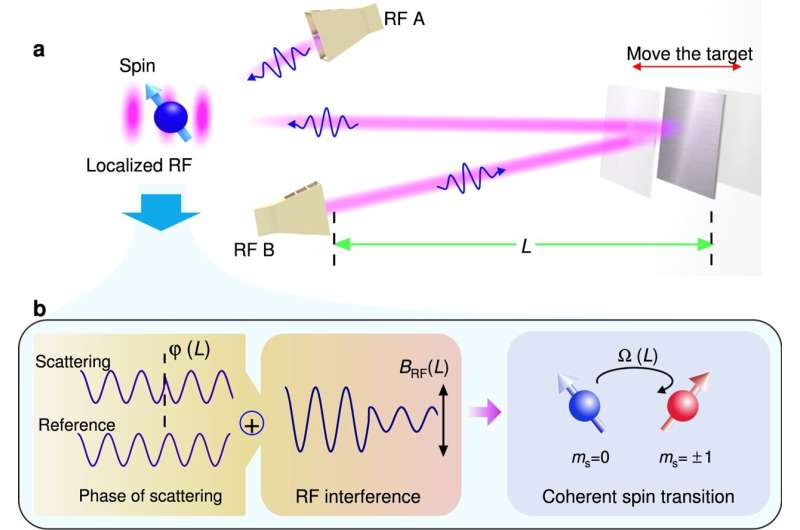Research team realizes quantum-enhanced microwave ranging

A study published in Nature Communications highlights the progress made in practical quantum sensing by a team led by academician Guo Guangcan and Prof. Sun Fangwen from the University of Science and Technology of China (USTC) of the Chinese Academy of Sciences (CAS). The team utilized micro and nano quantum sensing, coupled with local electromagnetic field enhancement at deep sub-wavelength scales, to study the detection of microwave signals and wireless ranging, achieving a positioning accuracy of 10-4 wavelengths.
Radar positioning technology based on microwave signal measurement is widely used in activities such as automatic driving, intelligent manufacturing, health monitoring, and geological exploration. In this study, the research team combined quantum sensing of solid-state systems with micro/nano resolution and deep subwavelength localization of electromagnetic fields to develop high-sensitivity microwave detection and high-precision microwave positioning technology.
The researchers designed a composite microwave antenna composed of diamond spin quantum sensors and metal nanostructures, which collects and converges microwave signals propagating in free space into nano-space. By probing the solid-state quantum probe state in the local domain, they measured the microwave signals. The method converted the detection of weak signals in free space into the detection of electromagnetic field and solid-state spin interactions at the nanoscale, improving the microwave signal measurement sensitivity of solid-state quantum sensors by 3–4 orders of magnitude.
To further utilize the high sensitivity microwave detection to achieve high-precision microwave localization, the researchers built a microwave interferometry device based on the diamond quantum sensor, and obtained the phase of the reflected microwave signal and the position information of the object through the solid-state spin detection of the interference result between the reflected microwave signal and the reference signal of the object. Based on the coherent interaction between solid-state spin quantum probes and microwave photons multiple times, they achieved quantum-enhanced position measurement with an accuracy of 10 micrometers (about one ten-thousandth of the wavelength).
Compared with traditional radar systems, this quantum measurement method does not require active devices such as amplifiers at the detection end, reducing the impact of electronic noise and other factors on the measurement limit. Subsequent research will allow further improvement of radio localization accuracy, sampling rate, and other indicators based on solid-state spin quantum sensing, and the development of practical solid-state quantum radar localization technology that exceeds the performance level of existing radars.
More information:
Xiang-Dong Chen et al, Quantum enhanced radio detection and ranging with solid spins, Nature Communications (2023). DOI: 10.1038/s41467-023-36929-8
Citation:
Research team realizes quantum-enhanced microwave ranging (2023, April 7)
retrieved 7 April 2023
from https://phys.org/news/2023-04-team-quantum-enhanced-microwave-ranging.html
This document is subject to copyright. Apart from any fair dealing for the purpose of private study or research, no
part may be reproduced without the written permission. The content is provided for information purposes only.
For all the latest Science News Click Here
For the latest news and updates, follow us on Google News.

